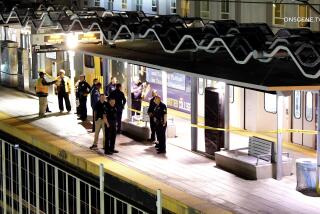Train Safety Ad Has Eerie Resemblance to Fatal Accident
- Share via
Two joggers head out for a run. One is wearing headphones. They manage a steady pace as they jog along a set of railroad tracks.
Suddenly, a train bears down on them from behind.
Unable to stop in time, the train slams into one of the joggers--and kills him.
It’s a scene eerily reminiscent of an accident last week in Corona that killed two joggers out for a run on railroad tracks.
This, though, is a television commercial filmed just two weeks before the Corona accident by a railways trade agency in hopes of preventing the hundreds of deaths each year nationwide--471 in 1996--that could be avoided if walkers and joggers would simply stay away from the tracks.
California led the nation in 1996 in such deaths, with 68, according to data provided by the Federal Railroad Administration to the trade agency, the Washington, D.C.-based Assn. of American Railroads. Next were Texas, with 60, and Illinois, with 32.
“California has a large population and significant train-track mileage and a reputation for sunny skies and outdoor recreation,” agency spokesman John F. Fitzpatrick said.
“Too often, when folks are outdoors, they’re drawn to train tracks,” Fitzpatrick said. But railroad tracks--as well as trestles, tunnels and yards--are private property, and walking or jogging on the tracks is trespassing, he said.
The Sept. 28 accident killed Raymond Votaw, 53, and Michael Grady, 45, both of Corona. Officers did not say which of the two was wearing headphones.
They were jogging on a set of tracks while en route to a nearby park--to meet other members of their running club--when they were struck and killed by a Metrolink train on a special run carrying motor racing fans to the California Speedway.
Metrolink trains do not normally operate on Sunday. Both Votaw and Grady were killed instantly, Corona police said.
The television commercial was filmed near San Diego on Sept. 14 as part of a public service advertising campaign titled “Highways or Dieways,” Fitzpatrick said.
The commercial is due to begin airing in early 1998 along with two other spots that highlight the dangers of ignoring rail safety signs and signals while driving, Fitzgerald said.
The 4,257 car-train collisions last year in the United States killed 488 people, 24 in California, and injured 1,610 others. In Texas, 61 people were killed in such collisions, the most in the nation.
The Assn. of American Railroads, which represents freight railroads and Amtrak, produced the commercials in conjunction with Operation Lifesaver, a national nonprofit group based in Alexandria, Va.
“People know not to walk on highways where cars travel up to 60 mph,” Fitzpatrick said. “But for reasons that are hard to understand, they think it’s OK to walk on train tracks where trains can travel up to 60 mph.
“These are trains that can take up to a mile and a half to stop and cannot steer out of the way of a person or a car blocking the tracks.”
“People just don’t understand,” Fitzpatrick said. “People need to be responsible for their actions. And too often they’re not.”
More to Read
Sign up for Essential California
The most important California stories and recommendations in your inbox every morning.
You may occasionally receive promotional content from the Los Angeles Times.










